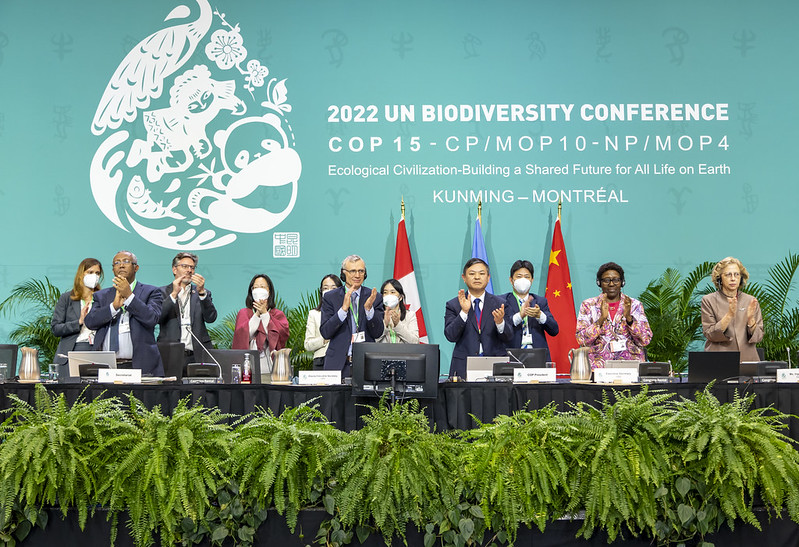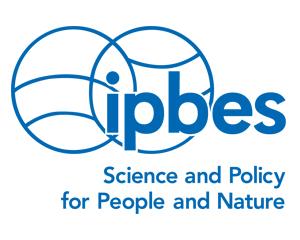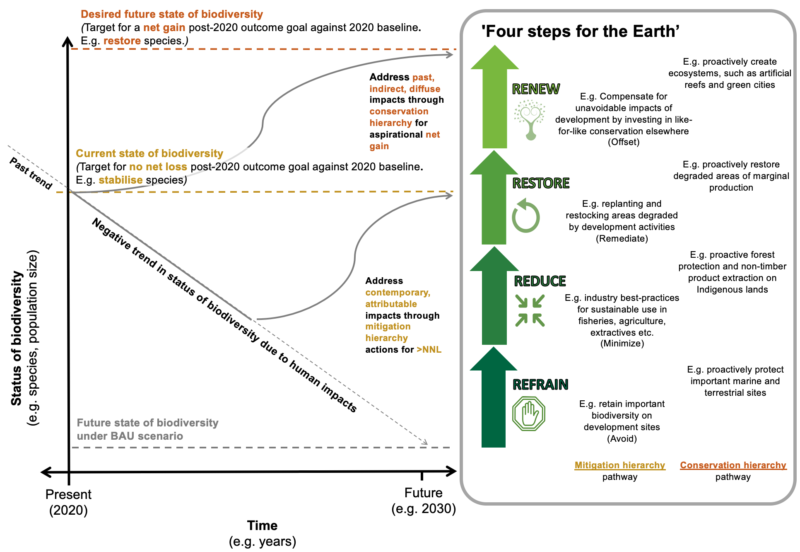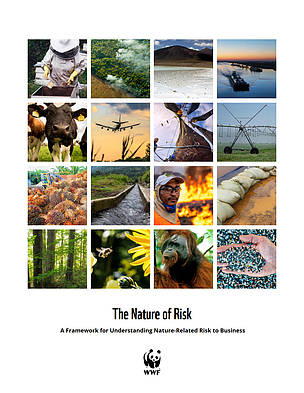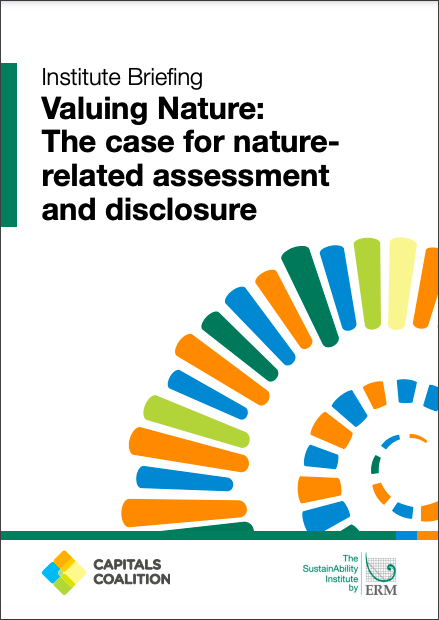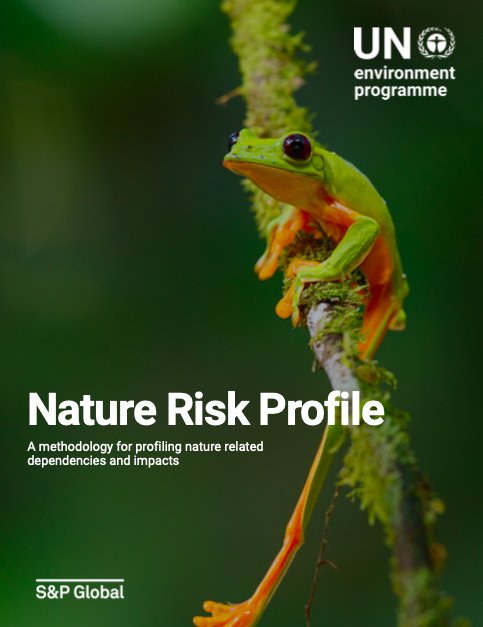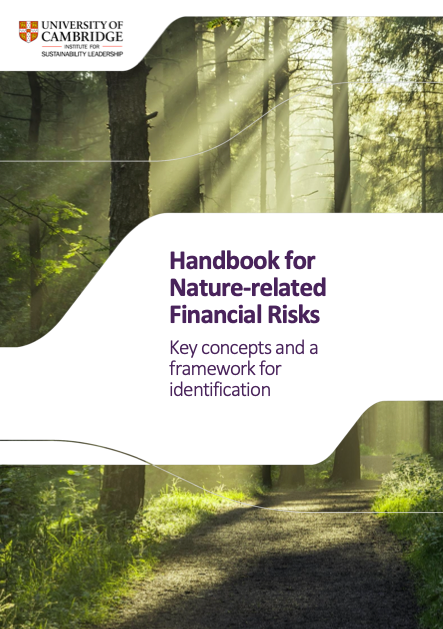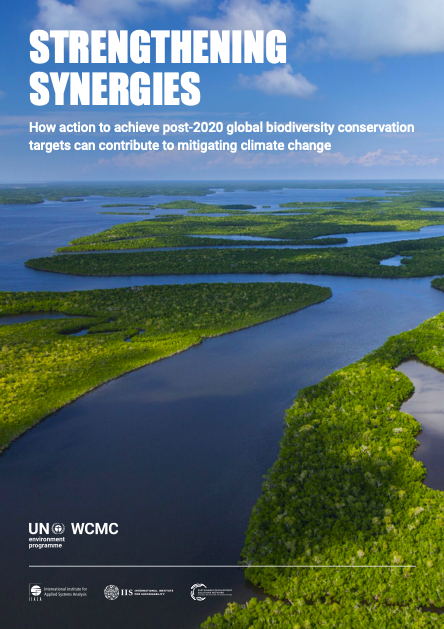General Resources
Description
Introductory resources and reference materials to help acquaint you with issues related to ecosystems.
Share this Subissue on:LinkedIn
Resources
Understanding Nature
The Kunming-Montreal Global Biodiversity Framework
Agreed upon at the 15th meeting of the Conference of Parties to the UN Convention on Biological Diversity, this global framework sets out to preserve and restore nature, protect biodiversity, prevent extinction of species, ensure sustainable use, and promote fair and equitable benefit sharing. It contains four ambitious goals for 2050 and 23 interim targets for 2030 that depend on collaboration between industries and governments at all levels.
Intergovernmental Science-Policy Platform on Biodiversity and Ecosystem Services (IPBES)
Established in 2012, the Intergovernmental Science-Policy Platform on Biodiversity and Ecosystem Services (IPBES) is an intergovernmental organisation that was created to "strengthen the science-policy interface for biodiversity and ecosystem services for the conservation and sustainable use of biodiversity, long-term human well-being, and sustainable development." They are a knowledgeable and reputable source for content that will support your understanding of nature's contributions to human well-being.
The IPBES produces assessments on specific themes and issues at both the regional and global levels; supports policy development; builds capacity and knowledge for participating member states; provides tracking to show the impact of their knowledge materials on decision-making; and engages in communications, outreach, and awareness-building on key ecosystem-related topics.
The IPBES Global Assessment Report on Biodiversity and Ecosystem Services
This report is the first ever intergovernmental global assessment on the status and trends of the natural world; their direct and indirect causes; the social implications of these trends; and the actions that can be taken to ensure nature is conserved, restored, and used sustainably. The assessment presents a comprehensive analysis and synthesis of scientific publications, indigenous knowledge, and local knowledge to highlight the impact of biodiversity and ecosystem services on human well-being and the effectiveness of responses, including the Strategic Plan for Biodiversity and its Aichi Biodiversity Targets.
The summary for policymakers would be of particular value to directors, or to sustainability change agents for the creation of learning materials.
The Convention on Biological Diversity
The Convention for Biological Diversity (CBD) aims to provide a global framework for biodiversity action. The CBD has three main goals: conserving biodiversity, achieving the sustainable use of its components, and fairly and equitably sharing the benefits arising from genetic resources. The CBD brings together the Conference of the Parties (COP) every two years to review progress, adopt programs, and provide policy guidance. Among their achievements is the Strategic Plan for Biodiversity 2011-2020, which provided an overarching biodiversity framework for the entire UN system and all partners involved in policy development. This plan includes the Aichi Biodiversity Targets, which were established in an effort to protect and conserve the biodiversity that underpins global food security, health and clean water.
The CBD website is a rich source for learning materials on biodiversity indicators and required actions; primer guides on the Aichi Biodiversity Targets; information on national biodiversity strategies and action plans; and more.
The Nagoya Protocol on Access and Benefit-sharing
The Nagoya Protocol is an international agreement which aims at sharing the benefits arising from the use of genetic resources in a fair and equitable way. Supplementary to the Convention on Biological Diversity, it was developed to create greater legal certainty and transparency for both providers and users of genetic resources by establishing more predictable conditions for access to genetic resources, as well as helping to ensure benefit-sharing when genetic resources leave the country providing the genetic resources.
What Is The Mitigation & Conservation Hierarchy?
This framework from the Conservation Hierarchy outlines four steps (refrain, reduce, restore, and renew) that can be implemented to help businesses advance nature-positive outcomes. The steps can be implemented via two pathways: the mitigation hierarchy, for mitigating future negative impacts, and the conservation hierarchy, for delivering additional conservation potential. The framework is based on the well-established 'mitigation hierarchy' for addressing impacts on biodiversity, and moves beyond it by recognising the need to address past, indirect, and diffuse negative impacts on biodiversity and by combining impact mitigation and proactive conservation. Understanding and implementing this framework is an important starting point for any business that is committed to addressing its direct and indirect impact on nature.
The IUCN Red List Index
Established in 1964, the International Union for Conservation of Nature’s Red List of Threatened Species is the world's most comprehensive information source on the global extinction risk status of animal, fungus, and plant species. The index shows trends in overall extinction risk for species, and is used by governments to track their progress towards targets for reducing biodiversity loss. It is also used to guide scientific research, inform policy and conventions, influence resource allocation, and inform conservation planning.
IPBES Assessment Report on the Interlinkages Among Biodiversity, Water, Food and Health
Also known as the Nexus Report, this new landmark report from IPBES provides an ambitious scientific assessment of the complex interconnections between biodiversity, water, food, health, and climate change. Nexus approaches are crucial; despite the intertwined nature of the drivers and underlying causes of degradation of biodiversity, water, food, health, and climate, existing actions to address these challenges fail to tackle the complexity of interlinked problems. Decisions to address these issues are often taken in isolation, resulting in potential misalignment, unplanned trade-offs, and unintended consequences.
The product of three years of work by 165 leading international experts from 57 countries from all regions of the world, the report explores past and current nexus interactions; future nexus interactions; response options that address nexus interactions; and transforming current siloed modes of governance for achieving just and sustainable futures. Although created for policy-makers, this summary is a good source of information for sustainability professionals - particularly for the creation of learning materials for senior leaders.
Agreement on Marine Biodiversity of Areas beyond National Jurisdiction
The United Nations agreement on biodiversity beyond national jurisdiction or BBNJ Agreement (referred to by some stakeholders as the High Seas Treaty or Global Ocean Treaty) is a legally binding agreement for the conservation and sustainable use of marine biological diversity of areas beyond national jurisdiction. Adopted in June 2023, the agreement addresses four main issues:
marine genetic resources, including the fair and equitable sharing of benefits
measures such as area-based management tools, including marine protected areas
environmental impact assessments
capacity-building and the transfer of marine technology
Understanding Nature-Related Risks and Corporate Action
The Taskforce on Nature-related Financial Disclosures
Reversing global nature loss depends on a shift in global financial flows away from nature-negative outcomes and toward nature-positive outcomes. This depends on large and small businesses across supply chains, financial institutions, and industries of all types collectively identifying, assessing, managing, and disclosing nature-related dependencies, impacts, risks, and opportunities. Towards meeting this inter-industrial challenge, the Taskforce on Nature-related Financial Disclosures (TNFD) was established in 2021 in response to the growing need to factor nature into financial and business decisions.
The TNFD has developed a market-led, science-based risk management and disclosure framework for organisations to report and act on evolving nature-related risks and opportunities. The TNFD has also developed case studies and sector-specific guidance; a Knowledge Hub that features a curated collection of the latest external resources and market insights on nature-related risks and opportunities; and an open-access Learning Lab that supports self-paced learning about nature-related issues, the TNFD recommendations, and additional guidance.
IBAT Biodiversity Map
The TNFD and IBAT Alliance have collaborated to create an integrated version of the Integrated Biodiversity Assessment Tool's biodiversity map on the TNFD website. This interactive map can help you to access critical biodiversity information and can be used to quickly screen for areas of biodiversity importance using the World Database of Protected Area, the World Database on Key Biodiversity Areas, and the IUCN Red List of Threatened Species. These datasets are recommended by the TNFD for assessing biodiversity importance as part of the TNFD's LEAP approach.
IPBES Transformative Change Assessment
This new assessment report from IPBES can help you to understand the cost of delaying actions to halt and reverse biodiversity loss; the benefits of taking action now; and the actions required to support transformative change. The Assessment Report on the Underlying Causes of Biodiversity Loss and the Determinants of Transformative Change and Options for Achieving the 2050 Vision for Biodiversity – also known as the Transformative Change Report - estimates that delaying necessary action by even a decade will double the costs of acting now and explains how shifting immediately toward regenerative and nature-positive economic approaches can unlock massive opportunities for industry and innovation. The report explains why transformative change is urgent, necessary, and challenging, yet possible; explains five key strategies and associated actions for transformative change; and explores the roles that we can play to enable transformative change. This resource will be most beneficial to sustainability, risk, and strategy professionals, and especially those evaluating nature-related risks and opportunities.
The Nature of Risk
Scientific consensus is growing around risks to business from the loss and degradation of nature. This report and framework from WWF builds on existing natural capital and climate-related risk frameworks, and will help you understand the extricable link between nature- and climate change-related risks. This resource also includes a set of case studies featuring businesses facing the consequences of nature-related risk.
Climate Risk Assessment for Ecosystem-based Adaptation: A guidebook for planners and practitioners
This guide is a good starting point if your organisation is looking to preserve at-risk natural spaces from climate change impacts. The guide focuses on ecosystem-based adaptation, which involves the use of biodiversity and ecosystem services to help communities adapt to the negative effects of climate change and to reduce their risk to environmental hazards. This handbooks will help you to perform sound assessments of climate risks for social-ecological systems, and provides guidance on how to systematically consider ecosystems and their services as both a driver of risk (when function is reduced) and as an opportunity for risk reduction and adaptation. This document introduces key concepts and methodological steps relevant for ecosystem-based adaptation; identifies potential adaptation measures; and explains how to perform related planning and use risk assessments for monitoring and evaluation.
ENCORE (Exploring Natural Capital Opportunities, Risks, and Exposure)
ENCORE (Exploring Natural Capital Opportunities, Risks, and Exposure), a free tool from the Natural Capital Finance Alliance, can help you to visualise how your business may be exposed to accelerating environmental change. The tool provides a snapshot of the dependencies and impacts for a wide range of sub-industries and processes, and includes fact sheets and maps to help you understand the links between business activities and nature.
Nature Benchmark
The Nature Benchmark measures and tracks corporate performance towards a nature-positive future and ranks keystone companies on their efforts to protect biodiversity and the environment. Created by the World Benchmarking Alliance, the benchmark provides publicly available, evidence-based insights into how the world's most influential companies are contributing to the preservation and regeneration of nature. The Nature Benchmark specifically reviews the policies and practices of companies spanning a range of industries with a particularly significant impact on nature: metals and mining; food and agriculture; construction and engineering; construction materials and supplies; containers and packaging; paper and forestry products; pharma and biotech; tyres and rubber; apparel and footwear; and chemicals.
Valuing Nature: The case for nature-related assessment and disclosure
This report by the SustainAbility Institute and the Capitals Coalition builds a case for nature-related disclosure and provides a roadmap for how businesses can approach it. The report unpacks new nature frameworks; connects the Capitals Coalition’s Natural Capital Protocol with the Taskforce for Nature-related Financial Disclosure's (TNFD) beta framework; and outlines a set of nature-related actions that your company can and should take today. This is a good resource for preparing leaders and boards to make clear, consistent, and timely nature-related disclosures upon the TNFD's launch.
Roadmaps to Nature Positive
This series of roadmaps produced by WBCSD can help you understand how to credibly take action that supports nature. It consists of one foundational roadmap for all businesses, and additional roadmaps for key sectors such as agriculture, forests products, buildings, and energy. These resources are aligned with leading sustainability frameworks and can support companies in developing science-based targets for nature, reporting against the Taskforce for Nature-related Financial Disclosures (TNFD) and the EU's Corporate Sustainability Reporting Directive (CSRD), and taking priority actions in line with the Global Biodiversity Framework, which calls for stopping or reversing nature loss by 2030. This guidance will be most useful to sustainability and supply chain teams.
Nature Risk Profile
This guide from UNEP was created to support the financial sector with measuring and addressing nature-related risk. The guide outlines a methodology and provides scientifically robust and actionable sustainability analytics that can help you to assess your company's impacts and dependencies on nature.
Climate and Nature: A Route to Mutual Acceleration
This briefing sheet from the Cambridge Institute for Sustainability Leadership (CISL) can help you understand how necessary, joint action on nature and climate can be scaled up. It outlines six critical actions for business, financial institutions, and governments, addressing policymaking, finance, business strategy, behaviour change, collective resource management, and value chains. This brief will be most useful to sustainability practitioners across sectors, and especially as a primer for senior leaders.
Guidance on engagement with Indigenous Peoples, Local Communities and affected stakeholders
This comprehensive guide from the Taskforce on Nature-related Financial Disclosures (TNFD) can help ensure that your approach to nature-related issues is informed by Indigenous Peoples and local communities. It explains how to meaningfully engage with stakeholders and rightsholders affected by your operations and value chain. It outlines an engagement process that includes identifying who to engage, reviewing existing standards and regulations, mapping relevant stakeholders, understanding modes and principles of good engagement, and monitoring. This detailed guidance also helps you to align with TNFD disclosure standards. It will be most useful to sustainability and community relations teams.
Handbook for Nature-related Financial Risks: Key concepts and a framework for identification
This handbook from the University of Cambridge Institutite for Sustainability Leadership (CISL) explains how nature loss is a risk to financial institutions. Created to help financial practitioners with limited prior knowledge of biodiversity loss, land degradation, and other ecosystem-related sustainability topics, it provides an overview of key terms and concepts and features a framework for identifying various nature-related financial risks (as well as relevant physical, transition, and liability risks). This is a good starting point for practitioners who want to better understand how to embed nature-related financial risks into strategy and decision-making.
Nature Strategy Handbook: A practical guide for business
This concise and practical guidebook from It’s Now for Nature can help you develop and publish a nature strategy that contributes to the health and resilience of the natural world. The guide is structured in line with ACT-D High-Level Business Actions on Nature (Assess, Commit, Transform and Disclose). For each of these actions there are guiding questions, recommendations, and resources to enable development of a nature for strategy. This resource will be most useful to sustainability practitioners seeking to reduce their organisation’s negative impacts on nature while boosting resilience and long-term businesses value.
Nature and Climate Action: A Resource Navigator for Companies and Financial Institutions
This comprehensive resource created by the Global Commons Alliance, the Climate Champions Team, and AccountAbility can help you navigate the resource landscape for business action on nature and climate. Section 4 maps out global frameworks, standards, methodologies, and decision-making tools, and section 6 provides a step-by-step pathway to learning and features resource tables that align with the target-setting frameworks of the SBTN and SBTi. Sections 7 and 8 then provide in-depth summaries of key resources. This resource will be especially useful to professionals seeking clarity on the use of both new and well-established sustainability tools and frameworks.
Accountability for Nature: Comparison of Nature-Related Assessment and Disclosure Frameworks and Standards
This report from UNEP can help you understand the evolving landscape of nature-related disclosure frameworks and assessments. It compares the approaches of major frameworks, such as CDP, ESRS, GRI, ISSB, SBTN, and the TNFD, highlighting common trends and identifying the ways in which they differ. The authors plan future research as continued changes are expected, such as the transition from voluntary to mandatory disclosure requirements. This resource will be especially useful to sustainability practitioners and legal teams.
A Guidebook for Business on Nature
This guidebook from the World Resource Institute provides a simple and actionable framework that can help you to integrate nature into decision-making. Based on a literature review and input from 41 corporate actors and grounded in real-world insights and case studies, the guide introduces the SPARK framework (and its abridged variant, the ARK framework). The SPARK framework consists of three essential steps (A, R, K) for action on nature and two optional preliminary steps (S and P) that can help companies to determine materiality. The SPARK framework recommends that users Start by identifying risks and opportunities; Prioritise significance; Assess support and action for nature; Refine operational mechanisms; and Kick off and evaluate. The guide features key questions to consider for each step; highlights case studies of companies that have successfully implemented nature-related initiatives; and identifies internal and external enablers for action and potential barriers to action. This guidebook will be particularly beneficial to corporate decision-makers tasked with translating nature-related commitments into action, including executives and cross-functional teams in strategy, finance, risk, and operations.
Asking Better Questions on Nature – For board directors
This guide was created to help board directors inform their nature-relation decision making by surfacing critical insights about nature-related dependencies, impacts, risks, and opportunities. Created by the TNFD in collaboration with Chapter Zero, Competent Boards, the Commonwealth Climate and Law Initiative, and the Green Finance Institute, the guide features twelve questions related to nature's relevance to your business; integrating nature into decision making; understanding the external context; organisational competence on nature-related issues; and board reflection. These questions have been identified based on discussions with experienced executive and non-executive board directors of leading organisations that are already considering climate- and nature-related issues.
The Little Book of Investing in Nature
Contrary to its modest name, this comprehensive resource from Global Canopy can help you to better understand the range of options available for financing nature conservation. The book introduces an overarching framework that organises biodiversity financing mechanisms into five categories: revenue generation, better delivery, expenditure realignment, avoidance of future expenditures, and catalysts. The book uses a set of common criteria that are presented graphically with icons so as to facilitate comparison of the various available financing options within each category. This resource will be especially beneficial to sustainability and finance teams.
Nature's Price Tag: The economic cost of nature loss
This report from Ceres can help you to better understand the economic implications of nature loss. It quantifies the cost of nature loss by driver (including land and sea use change, the overexploitation of natural resources, climate change, pollution, and the spread of invasive species) and relevant ecosystem services for eight unique sectors: biotechnology and pharmaceuticals, chemicals, consumer goods retail, food and beverage retail, food production, forestry and packaging, household and personal goods, and metals and mining. It provides risk profiles for each sector, defining priority areas for nature action based on potential economic losses tied to ecosystem service dependencies. It also provides an engagement framework around four areas of company action: assessing impacts and dependencies; making commitments and setting targets; transforming the value chain; and creating an enabling environment. For each area, the report lists indicators that investors can look for to assess corporate progress. This framework will be particularly beneficial to financial institutions and finance professionals that want to better understand and engage portfolio companies on nature-related risks.
ISO 17298: Biodiversity for organizations – Guidelines and Requirements
This ISO standard provides a practical, scalable framework that can help your organisation to assess its biodiversity impacts, dependencies, risks, and opportunities and take measurable, accountable action to protect and restore biodiversity. It offers a structured roadmap that enables organisations to assess biodiversity-related impacts and consider these effectively in their strategies. It embeds biodiversity into core governance and risk management practices, better ensuring alignment with global expectations and organisational operations. This standard is designed to be interoperable with other widely used initiatives, such as ISO 14001, ISO 26000, TNFD, and the Sustainable Development Goals (SDGs), and contributes directly to the Kunming-Montreal Global Biodiversity Framework.
Natural Capital: The Next Evolution of Environmental Reporting
This paper from ISS Governance can help you to better understand the state of play regarding natural capital reporting and developments in the proxy voting space. It highlights the evolution of reporting frameworks and their common themes; provides stakeholder groups mapping; and features analyses of natural capital-related shareholder proposals, including those related to agricultural impacts, chemical pollution, deforestation, extractive impacts, lobbying, plastic pollution, and water-related risks. This resource will be especially helpful for change agents supporting sustainability-related disclosures, senior leaders, and investor engagement professionals.
Returns on Resilience: Investing in Adaptation to Drive Prosperity, Growth and Competitiveness
This report, co-published between Systemiq and twenty other organisations, can help you to understand the scale and scope of society-wide benefits from investing in climate and nature resilience. The report presents strong evidence that adaptation is not just a moral imperative, but rather a strategic investment in sustainable growth. It makes the case for investments in resilience, unpacks the resilience investment agenda, and identifies priority actions for economic and financial decision-makers. It also identifies fifteen high impact, cost-effective solutions that generate strong socioeconomic returns and are critical for enhancing resilience and delivering key development outcomes, including crop resilience, heat mitigation, water collection and storage, digital public infrastructure, and more.
Nature Action Portal
Co-created with 100+ leading companies, this resource from WBCSD can help you to start - or accelerate - your journey toward nature positive. It provides a four-step process to help you learn the foundations of nature as a business imperative, including drivers of nature loss, key risks and opportunities, and more; build a clear understanding of how your sector interacts with nature by exploring the most material dependencies, impacts, risks, and opportunities across your operations and supply chain; identify and select the actions that will have the greatest impact in halting and reversing nature loss within your company’s operations and supply chain; and navigate and select the most relevant and feasible metrics to measure and disclose progress on your chosen actions.
Nature Positive Transitions: Sectors
This report series from the World Economic Forum explores transformative pathways to halt and reverse nature loss by 2030. Grounded in the Kunming-Montreal Global Biodiversity Framework, the series focuses on critical sectors, such as chemicals, cement and concrete, mining and metals, and ports. It highlights the impacts and dependencies of these sectors on nature, as well as priority actions businesses can take to avoid and reduce negative impacts, mitigate nature-related risks, build resilience, and unlock opportunities across value chains. Each report identifies sector-specific material impacts on nature, such as pollution, land-use change and resource use, and offers actionable recommendations to align business practices with global biodiversity and climate goals.
Other Resources
Breaching planetary boundaries: Over half of global land area suffers critical losses in functional biosphere integrity
This study from the Potsdam Institute for Climate Impact Research and BOKU University can help you to understand how different regions of the world are moving beyond "functional biosphere integrity" - the ability of plants to help regulate the planet's life-support systems. In order to uphold functional biosphere integrity, plants must acquire enough energy through photosynthesis to maintain the material flows of carbon, water, and nitrogen that support ecosystems and their processes. Unfortunately, intersecting crises such as climate change, nature loss, and land cover conversion are eroding this capacity. The study finds that 60% of global land areas already exists outside the locally defined safe zone, and 38% are now in high-risk zones.
The study builds on the Planetary Boundaries framework published in 2023, which puts energy flows from photosynthesis at the center of those processes that co-regulate planetary stability. The study finds that stress from human activities on the Earth system can be measured by the proportion of natural biomass productivity that humanity is channeling into its own uses – through harvested crops, residues, and timber, as well as the reduction in photosynthetic activity caused by land cultivation and land sealing. The study added to this measure a second and strong indicator of biosphere integrity: complex structural changes in vegetation and in the biosphere’s water, carbon and nitrogen balances.
Strengthening Synergies: How action to achieve post-2020 global biodiversity conservation targets can contribute to mitigating climate change
Climate change and biodiversity decline are fundamentally connected, and therefore addressing these intersecting crises will require the development and deployment of nature-based solutions. This primer will help you to understand the role that achieving biodiversity conservation targets can play in reducing emissions to meet the objectives of the Paris Agreement. The report looks at the carbon stocks associated with areas identified as possible priorities to meet proposed global biodiversity conservation targets.
Nature Map Explorer
Using the best available scientific data, Nature Map Explorer provides a set of integrated global maps on biodiversity and ecosystems services that will help you to explore, visualise, and understand the geographic context of various ecosystem services and the impacts of human activities on them. The map features layers such as terrestrial habitat types, human impact on forests, species richness, and areas of global significance for conservation, and can support your efforts to design and implement policies and initiatives aimed at limiting biodiversity loss and reducing greenhouse gas emissions.
The Vitality of Forests: Illustrating the Evidence Connecting Forests and Human Health
This resource from WWF can help you to understand how forests and human health influence each other, and well as how conservation, protection, and restoration of the world’s forests is crucial to safeguarding and promoting human health and managing climate change and biodiversity loss. Synthesising key research, the report explores five categories of potential interactions between forests and human health: noncommunicable diseases like cancer and diabetes, environmental exposure, food and nutrition, physical hazards, and infectious diseases. It also identifies major information gaps and highlights paths for environmental and health sectors to collaborate.
This report does a great job of explaining the importance of forests beyond their recreational, carbon sequestration, and biodiversity conservation potential, and will be of benefit to any professionals in sustainability, community relations, procurement, resource management, and beyond who are working to address deforestation.
IUCN Global Standard for Nature-based Solutions (1st edition)
This global standard for nature-based solutions (NbS) is a hands-on tool that can help you deploy NbS in a consistent and credible manner. The standard consists of eight criteria and 28 indicators designed to create a common understanding of best practices for tracking, measuring, and verifying NbS. For each criterion there is guidance and a case study. This resource will be most useful to those involved in planning, investing in, and supporting large- and small-scale interventions, such as sustainability, finance, strategy, and R&D departments.
Building business cases for Nature-based Solutions
This pair of resources from WBCSD can help you understand and present the business case for investing in Nature-based Solutions (NbS). The NbS Blueprint is a detailed guide that outlines a six-stage process for developing your own NbS business case: 1) identify business challenges; 2) explore relevant NbS; 3) understand the full range of value NbS offers; 4) develop the NbS design and implementation plan; 5) estimate costs of the proposed NbS; 6) and compare NbS against other solutions using multi-criteria decision analysis. It also provides eight case studies that further illustrate how other companies have developed their business cases for NbS. The Solutions Map is a tool designed to complement stage 2 of the NbS Blueprint. It helps explore relevant solutions by categorising NbS based on the business challenge they address and the biomes where they are applicable. These practical tools will be most useful to sustainability, finance, and strategy teams.
Nature-based Solutions for corporate climate targets
This guide by the IUCN can help you understand what Nature-based Solutions (NbS) are and how they contribute to net zero and nature positive goals. It has three sections that cover the role of NbS in climate change mitigation, corporate climate strategies, and achieving societal net zero. It is also features illustrative graphics. This guide will be most useful as an overview or introduction to NbS for sustainability professionals and others.
State of Finance for Nature 2023
This annual report from the UN Environment Programme can help you understand the scale of financing needed to tackle climate, biodiversity, and land degradation-related challenges. It makes the case for large-scale investment in Nature-based Solutions (NbS), examines the current scale of financial flows driving negative impacts on nature, and examines the state of financial flows driving positive impacts through NbS. It also provides estimates on the extent of NbS financing required to reach key Rio Convention targets, such as limiting the rise in climate change to 1.5° C, protecting 30% of land and sea by 2030, and reaching land degradation neutrality by 2030. The report concludes with key findings and recommendations for green financing. These insights will be most useful to the sustainability, finance, and strategy teams.
Wildlife's contributions to people
This new research can help you to better understand, explain, and represent the contributions of wildlife to people. The research explores wildlife’s role in nature's contributions to people (NCP), and - using existing evidence to map wildlife contributions onto the conceptual framework of NCP - it finds that wildlife directly supports 12 of 18 NCP categories. This resource will be beneficial to those working to embed and/or communicate the importance of wildlife and nature to upholding the resilience of people and societies.
